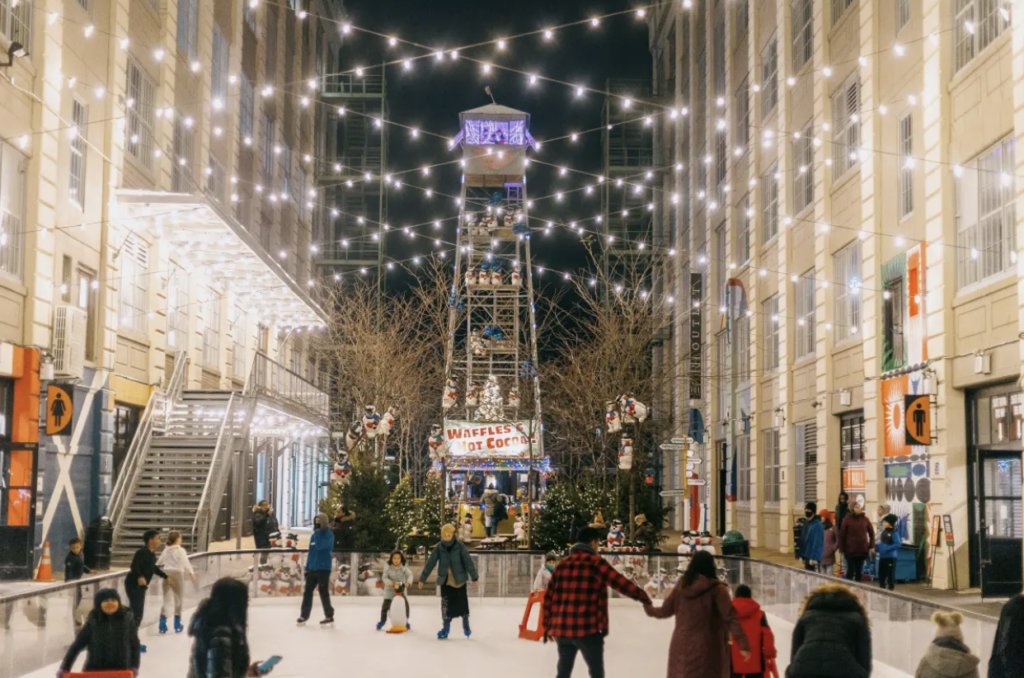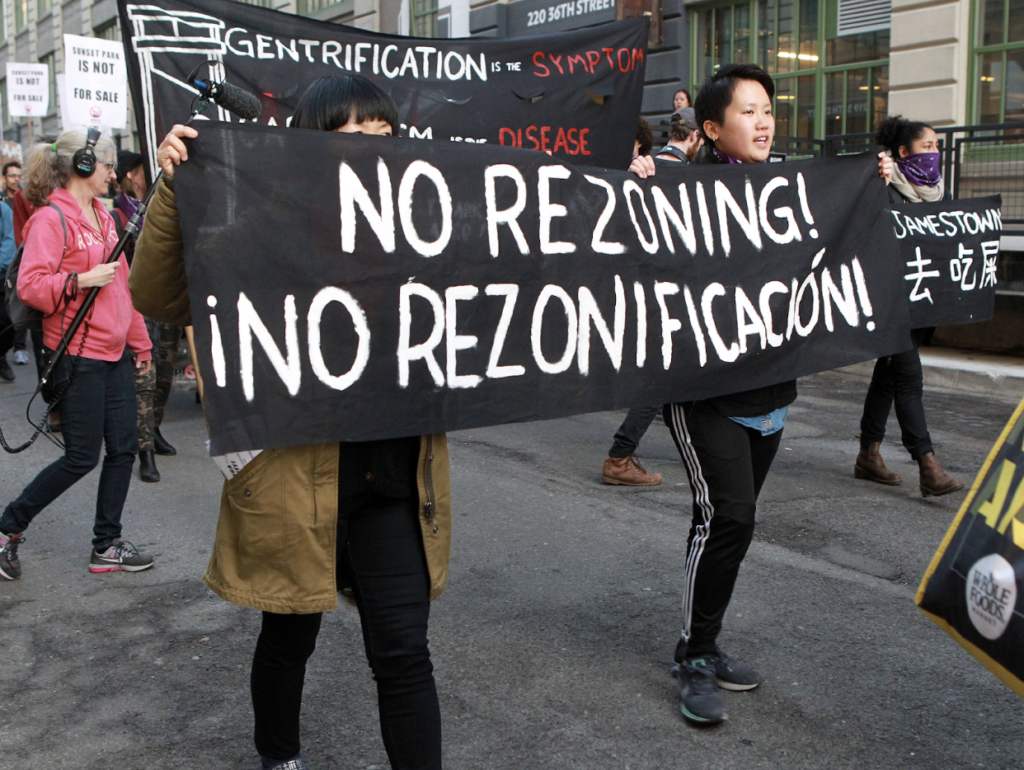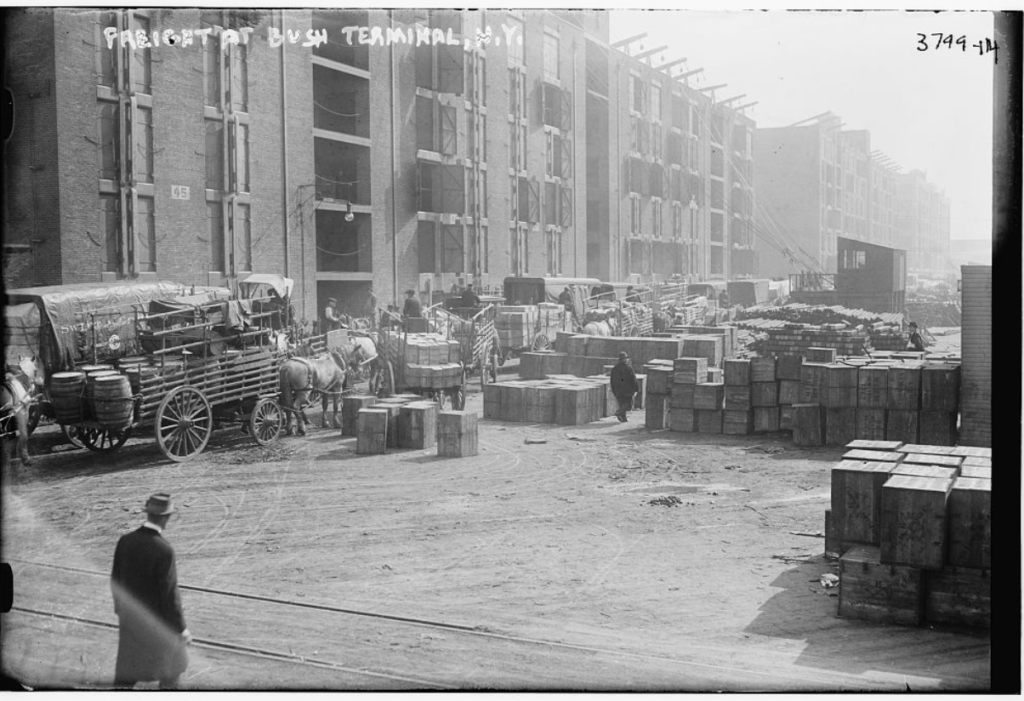The center for tourism and commercial space in Brooklyn is known as Industry City, a multicultural complex that spans multiple buildings across Sunset Park’s waterside. There is much to do, see, and eat at Industry City, but it is important to understand why this recent development, referred to by a New York Business article as a “$1B Brooklyn hipster mega-project,” was placed in the Latin and Asian enclave known for its large immigrant and working-class population. The extensive commercial hub did not come about without opposition – local representatives of the neighborhood adamantly rejected the plans for this space for fear of gentrification. Industry City was made to take over a long strip of abandoned factories and warehouses, what was once the center for industrial work and residential space, known as Bush Terminal. It was then revitalized by its CEO Andrew Kimball, with dubious assistance from the city government to become the Industry City we know today. This repurposing of an old warehouse space is not a new idea – this same development model has been done with Empire Stores, New Lab, and the Domino Sugar Refinery. We will explore the benefits and downsides of this model, as well as the type of people that occupy these spaces. What happens to the residents when their neighborhood is being transformed by capitalists trying to make some money? By exploring the history of the neighborhood, we will determine the consequences of Sunset Park’s billion dollar investment.
Sunset Park and Industry City: The Present
Industry City, explained by Cornell Real Estate as a “new mixed-use development set on 35 acres of centuries-old industrial land,” hosts a plethora of activities, dining experiences, and events across its 16 buildings. It has office space in the form of communal offices and rentable space throughout the hub, such as the Camp David Communal Office. This complex also hosts industrial facilities where production occurs, including the luxury Mast Brothers Chocolates. In addition, Industry City is the spot for well-known, pricey shops, like ABC Carpet and Home, St. Mark’s Comic Store, and Design within Reach. Of course, there are numerous options for a meal: the Arabic grocery store, liquor store, and restaurant Sahadi’s; a handful of Japanese eateries; the butcher shop Ends Meat; and more. If you want something to do on a Saturday, visit Industry City’s ice rink, film studios, dance classes, or night market. Additionally, Industry City houses Brooklyn’s own creatives through NYU Tandon’s Future Labs, a sake brewery, and private studios for artists. And if you see all of these options but nothing seems appealing to you, you can simply lounge inside or outside the buildings of Industry City or peruse the art pieces and murals that are on display throughout the complex. Clearly, Industry City has a lot to offer, and customers often struggle to explain the scope of it to people that have not visited. Industry City was built to offer a little bit of everything, intentionally isolating its visitors from the character of the neighborhood it occupies.

Who actually uses the spaces that Industry City created? One Saturday in March, I took the train to 36th street and surveyed a handful of people in Industry City. According to the data that I collected, 42% of those people did live in Sunset Park for quite some time. The rest of the people had, for the most part, come in from different neighborhoods of Brooklyn, like Gowanus and Crown Heights. Of this randomly chosen group of people, none were Hispanic. I looked around, and although there was a diverse crowd that day, I did not see more than five Hispanic families enjoying the space. The majority of the crowd was white, Black, and a substantial crowd of Asian people. When I spoke with someone from the neighborhood, they explained that locals often visit Industry City during the week, when the lines are shorter. The utilization of Industry City is not as simple as one may expect – people in the neighborhood do go to this complex, especially to grab lunch, while many others come in from different neighborhoods for dancing nights, haircuts, and to meet with friends. Industry City, is of course open to everyone, but undeniably attracts people from outside of Sunset Park. According to NYU Furman Center, the neighborhood of Sunset Park has been classified as an area undergoing gentrification. This was the goal of the project – to attract young wealthy people to the neighborhood to spend money and eventually settle down.

The diverse and largely residential neighborhood of Sunset Park surrounds this American Dream destination. Sunset Park, sandwiched between Bay Ridge and Park Slope, is home to a large Hispanic and Chinese population, known for its authentic cultural food and 25 acre park from which its name comes. Sunset Park lives along the waterside and its own pier, which is now occupied by Industry City. However, prior to Industry City, the notorious Robert Moses and the city government disconnected Sunset Park from its waterfront by demolishing parts of the neighborhood to build the Brooklyn-Queens Expressway. Additionally, Sunset Park is known for Green Wood Cemetery – a famous and quite beautiful cemetery of Brooklyn. But what Sunset Park has always been is a home for many immigrants because of its historically affordable housing – something that is now under recent threats. I have close ties to this neighborhood – my Puerto Rican family all first lived in Sunset Park, so I grew hearing stories about its tightly knit communities of working-class Latinos. Sunset Park is quite different from other areas of the city; it is full of thriving small family-owned businesses that have been in existence since my grandmother was a teenager. Even throughout the demographic changes that have occurred over the past few years, with a substantial Chinese, Japanese and non-Puerto Rican Hispanic population moving in, Sunset Park has remained a haven for small businesses and blue-collar workers.

Industry City: The Past
In 2013, “a consortium of ‘innovation hub’ developers and global equity investors” (Progressive City) took interest in Sunset Park’s struggling waterfront and decided to redevelop it – this effort was led by Jamestown LP, Belvedere Capital, and Angelo Gordon. Their goals with the redevelopment were to revitalize Sunset Park’s waterside, increase the job market, and attract a certain type of creative crowd to Sunset Park. They used primarily private funds from the companies, racking up an initial half a billion dollars, and they planned to profit off the space they were creating. When residents heard about this mega-project, they worried about how it would change their neighborhood. Many worried that Industry City, which was originally going to include hotels, would drive increased rent, displace long-term residents, and attract luxury housing and retail. Many residents also believed that Industry City would clash with the neighborhood’s identity and long-standing affordability; community groups, such as Protect Sunset Park, even came together to oppose this real estate plan. The potential increase in jobs was met with skepticism over who would really benefit from the jobs offered. Talk of Industry City propelled an ongoing discussion about the ethical responsibility to balance existing community needs and equitable growth. For example, in a 2019 public meeting, Council Member Carlos Menchaca was berated by attendees for his consistent defense of Industry City. Community members adamantly rejected any rezonings of Sunset Park. They critiqued the city’s land use process as performative and clearly biased toward wealthy developers, rather than what is beneficial for the people living in the community.

To fully understand the dilemma that Sunset Park was facing with Industry City, we must go back in time and learn about the history of the space. During the late 1800s, this area was a hub for shipping and industrial work. Then, in 1895 Bush Terminal was created by the new owner Irving T. Bush and designed to be a shipping complex. Bush Terminal was existing until 1905, when it was eventually sold to different companies. The space transformed into a giant industrial complex, known for its garment factories, warehouses, and shipping docks and employing tens of thousands of workers. In both world wars, the warehouses and factories were used for military supply storage and the piers were vital for other military operations. After World War II, the space fell into disrepair and became largely abandoned. Then, in the early 2000s as some manufacturing was occurring at these sites, developers were eyeing the area for a bold purchase. In 2013, the three companies – Jamestown LP, Belvedere Capital, and Angelo Gordon – purchased the land and began to transform it into a creative hub. Bush Terminal and the subsequent owners used the space as manufacturing, shipping, and storage, offering jobs to numerous residents of Sunset Park who were in need of blue-collar labor. Now, Industry City has become a hipster space for people to enjoy novel meals and according to an article from Progressive City, an “experiential retail and cultural destination.”

Industry City, a creative and commercial complex built on the site of industrial buildings, is not a new concept. Many well-known places are built on the very same model. For example, Chelsea Market, located by Chelsea Piers in Manhattan and developed by the same Jamestown LP that developed Industry City, was built on the site of an abandoned Nabisco factory. Now, it is home to retail stores, office space, and a multicultural food hall. The Navy Yard in Brooklyn, used to be a historic shipyard and is now the site of tech firms and film studios. In addition, this development plan is not even contained to the city – it happens across the United States. Take The Pearl in San Antonio, Texas, as an example. This former brewery was transformed into a tourist destination with restaurants, shops, and office space. When developers (with help from government representatives) create these innovative, privately-owned commercial spaces, they are purposefully increasing the rate of gentrification in that area. San Antonio’s Black and Latin populations were hit hard by the increase in property value, as the neighborhood’s ethnic and socioeconomic demographics rapidly changed. These spaces, although attractive, often destroy sites of historic industrial work (and the jobs that go along with it), rather than revitalize those places and their intended purposes. They bring about jobs that are not necessarily guaranteed to the long-time residents of the neighborhood that the place occupies. This is what residents of Sunset Park feared.

Sunset Park and Industry City: The Future
What will Sunset Park look like in the coming years? And how will Industry City play a role in the transformation of its neighborhood? Currently, activists are pushing for rent protections, more affordable housing, and community-led development. Community organizations, such as Protect Sunset Park and UPROSE, are working to include resident voices in development plans. There are efforts to preserve its cultural heritage as an enclave of Hispanic and Chinese immigrants – especially from groups such as El Grito de Sunset Park and Asian Community United Society. Sunset Park is also being developed into a climate-adaptive neighborhood through its participation in New York City’s Green Resilient Industrial District (GRID). And Industry City’s developers are finding new ways to expand within its zoning limits and attract more designers, tech firms, and small businesses.
The future of both Sunset Park and Industry City is unknown, but more must be done for the preservation and growth of this diverse neighborhood – developments in neighborhoods must directly benefit the residents above all. The city government should be advocating for its working-class residents rather than befriending millionaire private developers. Rather than deepen the cut between Sunset Park and its waterside, the city should have listened to its residents about what could have been done with that space.
